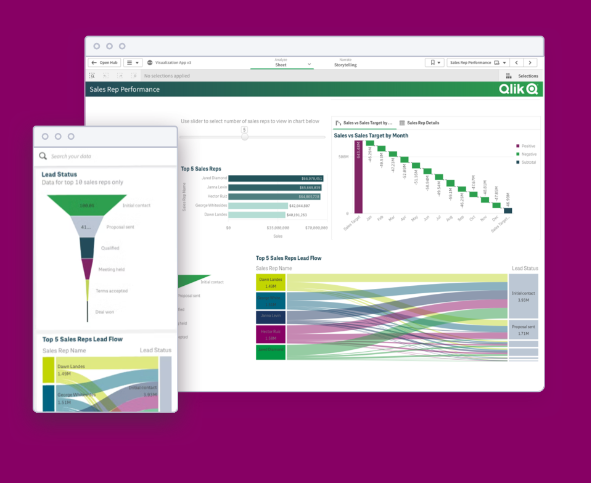
Data-driven innovations are empowering companies around the world to achieve unprecedented success. These organizations recognize, and are capitalizing on, data as one of the most valuable business assets.
The shift away from siloed data — where it’s isolated in different departments and systems, accessible only to tech and data professionals — is in motion. Data democratization is a goal shared by many companies: When everyone in an organization has access to data and analytics tools, the possibilities for data-driven insights and innovations are endless.
High levels of data literacy and access, however, require robust data platforms. One vendor that aims to support widespread data literacy and provide the means to achieve it is Qlik, which has championed data visualization and emerged as a cloud-first, but not a cloud-only, business intelligence (BI) provider.
Qlik is on the Acceleration Economy Top 10 Shortlist of Data Modernization Enablers.
Who They Are
Qlik was founded in Sweden in 1993 by Bjorn Berg and Staffan Gestrelius. Today, the company has over 38,000 enterprise customers and over 2,000 employees in 30 countries. Qlik headquarters are in King of Prussia, Pa.
In 2016, Qlik was acquired by the Chicago-based private equity firm Thomas Bravo for $3 billion. Specializing in software and technology investments, Thomas Bravo has several other data-focused organizations in its portfolio, including Alation.
Before the acquisition, Qlik had been trading publicly since 2010. From 2016 onwards, Qlik dedicated its development focus to becoming cloud-first, having previously focused on on-premise solutions.

Which companies are the most important vendors in data? Check out the Acceleration Economy Data Modernization Top 10 Shortlist.
CEO Mike Capone has been at the helm of Qlik since 2018, steering its cloud-first strategy. Before Qlik, Capone was COO of healthcare analytics firm Medidata Solutions.
Drew Clarke is Qlik’s Chief Strategy Officer, having previously held various positions at IBM and Cognos Software, which IBM acquired in 2008. James Fisher is the chief product officer at Qlik. Fischer was previously in product marketing for analytics, mobile, and finance solutions at SAP.
What They Do
Qlik delivers real-time, artificial intelligence (AI)-driven analysis by turning raw data into operational assets, ready for BI processes. “In the simplest form, our goal is to help customers drive more value from the data they have,” Fisher told Acceleration Economy. Although Qlik supports on-premise and hybrid environments, the company’s primary focus is the cloud. “Moving forward, the cloud is where the market’s going so that’s where we’re going and we think we have a very strong and capable offering there.”

“We pioneered a lot of the work around data literacy. What we focused in on is really helping our customers create a culture for the consumption and use of data, to help train people to know what it is to read, work, and act upon data, which is effectively the definition of data literacy.”
James Fisher, Chief Product Officer, Qlik
Qlik places its services into two categories: data integration and analytics. While the various elements of each function are available on-premise, at the heart of Qlik’s innovative product suite is Qlik Cloud.
“We have a cloud data and analytics offering which is designed to help customers take the data they have wherever that data resides, on-premise or in the cloud, and turn that raw data into analytics-ready data,” says Fisher. “There is context to it and it can be understood by a wider set of users in the organization and used to generate analytics and insights that answer key business questions.”
End-to-End Data Integration and Analytics in the Cloud
Qlik Cloud is a fully integrated platform supporting data integration, visualization, and analysis. The platform enables users to take actionable steps using real-time data. The platform supports hybrid cloud deployment options, enabling users to extract, store, and utilize data from multiple environments. Universal connectivity empowers users to flexibly move data to their chosen environments from many sources, such as data lakes, apps, relational, and non-relational databases, streaming services, and files.
Qlik’s Cloud Data Integration features include real-time data movement, allowing users to move data from on-premise or cloud sources on demand. Change Data Capture enables users to identify and capture changes in a database and deliver them in real-time, while Qlik’s technology can also automate the data ingestion process.
Qlik’s data transformation capabilities enable users to transform raw data into operational assets through auto-generated processes, while custom SQL can be added manually. A no-code interface makes it easy to design reusable pipelines. No-code is also a key element of Qlik’s workflow visual editor. This feature allows users to create automated workflows embedded into other applications to trigger alerts and govern downstream processes.
The platform lets users quickly understand data lineage and, from this information, determine its relevance. At the same time, the searchable catalog enables users to find and identify, share, and collaborate on data quickly and easily, regardless of technical knowledge.
Qlik Sense is the company’s visualization engine that’s available on-premise and as SaaS through Qlik Cloud. Qlik Sense is designed to be universally accessible through self-service visualizations, contextual calculations, interactive and shareable dashboards, and a range of visualization options. Powered by AI, Qlik Sense generates insights and automates the data preparation process. What’s more, natural language search and communication enable users to complete analysis and find relevant data easily.

These capabilities also automate actions and alerts. Qlik Sense provides real-time analysis with the tools to take immediate actions through embedded processes and dynamic dashboards. This approach is a key differentiator between Qlik and other organizations’ approaches to BI.
“Value comes from analytics when you do something different,” says Fisher. “The idea behind active intelligence is having insights that are actionable and what we’ve done with our platform and in the cloud offering is to move from an insight that can inform an action to an insight that can automatically trigger the action and the workflow in the end user’s business application.”
What’s Next?
Qlik’s product roadmap spans three core areas: data integration, analytics, and the foundational platform services that support both of those technologies. Moving forward, the company will continue to take a cloud-first but not a cloud-only approach, by investing in both cloud and on-premise innovations.
“Anything we do in our engine is shared between on-premises and the cloud so an application is portable between those two environments and customers get benefit across those use cases,” says Fisher. “At the same time, we’re obviously looking at ways in which you can use the cloud alongside client-managed use cases and AutoML is a good example of that.”
With the company’s AutoML technology, “You can operate a client-managed environment but run ML experiments and jobs in the cloud and return the results to a client-managed environment,” Fisher explains.
Expanding the breadth and depth of its integration capabilities, Qlik recently announced the Qlik Connector Factory, a dedicated set of resources focused on connectivity.
On the analytics side, Qlik is focusing on ease of use and the development of a joint data and analytics catalog that will drive more reuse of data models and analytics artifacts for business users.
“After 30 years as a CIO at firms that use IT to make stuff and deliver services, I have a bias towards suites. That means I prefer vendors that deliver multiple capabilities with a consistent interface and integration done for me. Qlik does both: It offers a variety of data management, governance, and BI tools designed for IT pros and end users alike, but packages those tools for quick deployment and rapid adoption.”
Wayne Sadin, CIO and Acceleration Economy Data Modernization analyst

Who They’ve Impacted
One of Qlik’s most significant enterprise customers is Honda, which turned to Qlik to support its digital transformation by enabling its staff to make data-driven decisions.
The 200,000-employee automobile manufacturer recognized a significant shift taking place in the industry with the advent of electric vehicles.

To adapt to market innovations and thrive in the new business landscape, Honda wanted to capitalize on its data to streamline operations and accelerate new service areas. Initially, the company onboarded a BI platform but needed a better solution supporting rapid visualizations for data teams.
After quickly seeing the results with Qlik, Honda expedited the technology to enable thousands of staff to work on independent data projects. With Qlik, Honda has reduced production costs and streamlined business operations. Whereas it took Honda months to produce automobile planning materials, the same task can now be completed in just one day.
“We needed to establish a culture where everyone was able to put data to work, and we needed to present environments and tools that made data easy to understand,” says Tsutomu Ogawa, chief engineer, Data Analysis and Utilization Section for Honda in a Qlik case study. “That is where Qlik solutions have played an important role.”
Why Qlik is on the Data Modernization Top 10 Shortlist
Qlik has been championing data visualization for decades. Now, with its end-to-end platform, customers are able to combine data analysis with data integration in the cloud. These are the key reasons Qlik was selected for the Data Modernization Shortlist by Acceleration Economy’s practitioner analysts:
- Qlik increases data literacy in organizations thanks to its intuitive, AI-powered visualization tools
- The Qlik Cloud platform unifies data integration and analytics, making it faster and easier to maximize use of data assets, while the suite appeals to customers by supporting a variety of functions in a single platform
- The Qlik solution, while cloud-focused, is flexible, supporting both hybrid and on-premise environments
- The company’s active intelligence expedites the availability of actionable data insights
- Major customers including Honda are using the technology in core enterprise applications that deliver quantifiable business benefits
Want more insights into all things data? Visit the Data Modernization channel:











